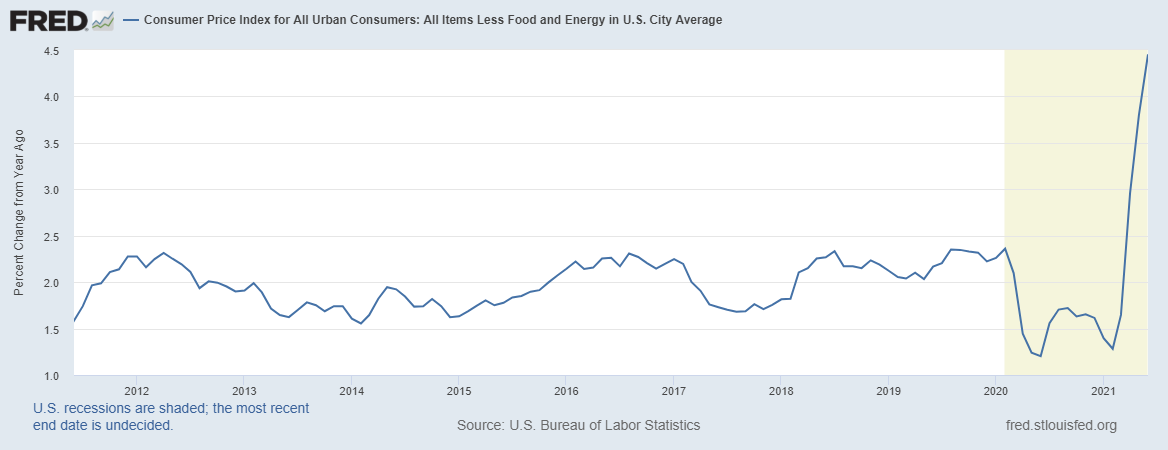
The Consumer Price Index (CPI) measure of inflation came in much higher (worse) than expected. Core CPI—which excludes volatile food and energy prices—increased 0.9% for the month, for an annualized increase of +4.5% (up from 3.8% last month). This is the highest annualized Core CPI reading since November 1991.
As I’ve said before, the Fed is being disingenuous when they say inflation will be transitory. Yes, the annualized inflation rate will likely moderate once supply chains get restored (hopefully!). But its still likely to remain elevated for awhile.

You can’t increase the money supply this much and not expect any adverse effects. We’ve seen a historic increase in the M2 money supply in response to the COVID recession, with year-over-year growth reaching +30% at one point. Unprecedented. This was the main difference between the 2008 recession response and today.
The good news is earnings have never been better and for some reason interest rates aren’t paying any attention. As I type this, the 10-year Treasury bond rate is actually lower for the day, at a measly 1.35%. Which goes to show why making investment decisions based upon predictions is a futile endeavor. You can get the prediction right (higher inflation) but still get the market move wrong (lower rates). It’s why I stick to the data only.

JP Morgan Quarterly Guide to the Markets chart package highlights the current dilemma for investors. Rates on savings accounts have never been worse (on average only $80 of income for every $100K in a savings account), while inflation is at a 30 year high.
To update this chart based upon the latest core CPI report, investors need $4,500 of annual income per $100K to keep up with current inflation rates. Current monetary policy has made it so investors are basically forced to take on more risk just to keep their purchasing power intact.
The last time we had an annualized Core CPI inflation rate this high was November 1991. Well, at that time the 10-year treasury bond rate was 7.4%. So investors could still keep up with inflation without having to adjust their risk profile. Not so today.
Today, the entire yield curve is negative after inflation. The only way to maintain your purchasing power is too increase your risk and hope for the best. The big problem with this approach is that stocks are far more risky then bonds, and can leave you failing to meet your goals if the time frame doesn’t line up. Times like these are where a qualified financial advisor will be beneficial.
This leads me to my main point. Although the fundamentals continue to support higher stock prices (as we review in the weekly market and economy recaps), I worry how much of these inflows are “paper hands,” to use Wall Street bets terminology. For those not familiar, “paper hands” is a term used to describe someone who “exits a position, or folds early because the financial risk is high. In other words, they panic sell. Their hands are described as paper because they fold or break with the slightest pressure.”
How many investors are now being forced into riskier assets to keep up with inflation? People generally feel like they can tolerate more risk when markets are rising, but bail at the first sign of trouble, which only makes the sell off worse. I don’t think its any coincidence that these market corrections are happening at lightening speed. The March 2020 30% decline in the market, was the fastest 30% decline ever. Not even during the great depression did the market fall 30% that fast.
The Fed is trying to create and maintain stability using assets which can become very unstable at times. You can’t print and spend money to prosperity. The New Deal of the 1940’s came with a very different dynamic, such as demographics, which makes these comparisons impractical.
It is earnings and interest rates that ultimately drive stock prices. And that’s the most important thing for investors. Those are both supportive of stocks. But in the short term, its sentiment (or change in valuation) that pushes prices above or below fair value. And that is impossible to predict with any consistency.
The best advice I can give is to stay balanced. Stay the course and enjoy the bull market but don’t fall for the temptation to chase the market higher either. We are in uncharted waters.
The Warren Buffett advice remains the best, “keep your head when everyone else loses theirs.” That’s applicable to both bull and bear markets.
For more, stay tuned to the weekly market recaps.
